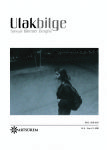GELENEKSEL SANATIN TASFİYESİ VE KAVRAMSAL TEPKİ
ELIMINATION OF TRADITIONAL ART AND CONCEPTUAL RESPONSE
Author(s): Bayram DedeSubject(s): Cultural history, Aesthetics, Post-War period (1950 - 1989), Sociology of Art
Published by: Sanat ve Dil Araştırmaları Enstitüsü
Keywords: Concept; Art; Writing;
Summary/Abstract: Conceptual art is an art movement that emerged in the 1960s. Introduced by Sol Lewitt for the first time, this art has made an important debate as opposed to traditional art. The effect of conceptual art and the innovations it brings are the aims of study. We need to analyze the conceptual art well to understand this. Conceptual art wanted to destroy many things and settle the past up. With the disappearance of art, the form has been completely weakened, and thought has begun to gain importance in art. Conceptual art has made a wholesale critique of western culture and rebelled against all kinds of artistic authority and monopolistic understanding. The artists started to make art with an idea that they embraced with their hearts. Conceptual art has provided access to large public communities that do not understand the artifacts, allowing them to descend into the streets by opposing the exhibition of artworks in the museum and the purchase and sale of them as commodities. It has tried to discover things that have not been tried before by expressing what is ordinary by taking aesthetic essence into the second plan. It has made a revolution in the the arts by opening the doors through which everyone could be an artist.
Journal: Ulakbilge Sosyal Bilimler Dergisi
- Issue Year: 6/2018
- Issue No: 25
- Page Range: 703-714
- Page Count: 12
- Language: Turkish

